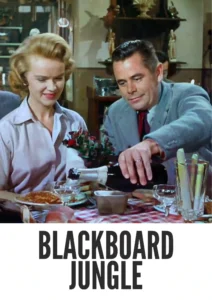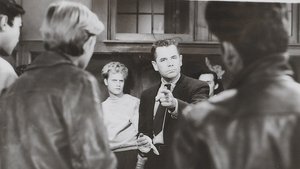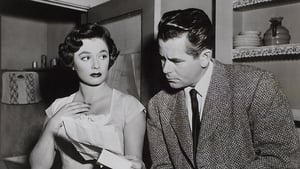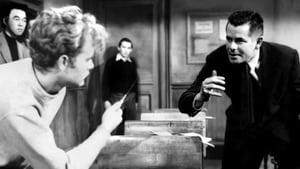Video Sources 0 Views
- Watch trailer
- Blackboard Jungle 1955 Colorized


Synopsis
Table of Contents
Toggle
Step back into the tumultuous classrooms of the 1950s with Blackboard Jungle, a hard-hitting social drama from 1955, now beautifully colorized to amplify its raw emotional power. Starring Glenn Ford and Sidney Poitier, this film fearlessly tackles the issues of juvenile delinquency, violence, and the challenges faced by educators in a changing society. More than just a movie, it’s a cultural milestone that ignited conversations and controversies. Perfect for those interested in social commentary, classic performances, and a slice of cinematic history, this HD download brings a powerful and relevant story to a new generation.
Blackboard Jungle plunges into the world of Richard Dadier (Glenn Ford), an idealistic World War II veteran who takes a teaching position at North Manual High School, an inner-city school plagued by unruly and disaffected students. Dadier quickly discovers that his classroom is a battleground, as he faces constant challenges from his students, particularly the charismatic but volatile Gregory Miller (Sidney Poitier).
As Dadier struggles to reach his students and maintain order, he encounters resistance from both the students and some of his fellow teachers, who have become jaded and resigned to the chaos. The film explores themes of alienation, prejudice, and the struggle for respect. It portrays the complex dynamics between teachers, students, and the community, highlighting the social issues that contribute to the students’ disruptive behavior.
The tension escalates as Dadier attempts to connect with his students, using unconventional methods and facing threats to his safety and family. The film culminates in a powerful confrontation that forces Dadier to make difficult choices and fight for his ideals. Blackboard Jungle is a gripping and thought-provoking film that explores the challenges of education and the potential for redemption in a troubled environment.
The film boasts a stellar cast of actors who deliver compelling performances:
-
Glenn Ford as Richard Dadier
-
Sidney Poitier as Gregory Miller
-
Anne Francis as Anne Dadier
-
Louis Calhern as Jim Murdock
-
Margaret Hayes as Lois Hammond
Blackboard Jungle falls into the genre of social drama, with elements of crime and suspense. Its unflinching portrayal of juvenile delinquency and its exploration of social issues make it a powerful and relevant film.
Released in 1955, Blackboard Jungle captured the anxieties and tensions of post-war America, particularly the rise of juvenile delinquency and the changing cultural landscape. The film is notable for its use of rock and roll music, featuring Bill Haley & His Comets’ “Rock Around the Clock,” which became an anthem for the youth rebellion of the era. The film’s depiction of violence and its frank portrayal of social issues sparked controversy and censorship in some areas. Despite the controversy, Blackboard Jungle had a significant impact on American culture, influencing subsequent films, television shows, and discussions about education and social problems.
This colorized version of Blackboard Jungle has been meticulously restored using advanced digital techniques, enhancing the visual impact while respecting the film’s original atmosphere and gritty realism. The colorization process involved a detailed analysis of the original black and white footage, with careful attention paid to historical accuracy and the film’s overall tone. The techniques employed included sophisticated algorithms for color palette selection, image enhancement, and artifact reduction. This painstaking process brings new life to the characters and settings, making the story even more accessible and engaging for contemporary viewers. While debates about colorizing classic films continue, this version aims to preserve the film’s legacy while introducing it to a broader audience.
-
: Richard Brooks
-
: Richard Brooks
-
: the novel Blackboard Jungle by Evan Hunter
-
: Russell Harlan
-
: Ferris Webster
-
: Metro-Goldwyn-Mayer (MGM)
-
: Metro-Goldwyn-Mayer (MGM)
-
: 101 minutes
-
: MP4
-
: HD (1080p)
-
: Compatible with most devices, including smartphones, tablets, computers, and smart TVs.
Blackboard Jungle (1955) is widely regarded as a landmark film in the social drama genre, praised for its unflinching portrayal of juvenile delinquency and its powerful performances. While some critics at the time questioned its sensationalism, the film has endured as a relevant and important commentary on American society. Its impact on popular culture and its influence on subsequent films and television shows solidify its place in cinematic history.
-
: What is Blackboard Jungle about?
-
A: Blackboard Jungle is a social drama about a teacher who struggles to reach his students in an inner-city school plagued by juvenile delinquency.
-
-
: Is Blackboard Jungle (1955) a controversial film?
-
A: Yes, Blackboard Jungle was controversial at the time of its release due to its depiction of violence and its frank portrayal of social issues.
-
-
: Is this version of Blackboard Jungle colorized?
-
A: Yes, this version has been professionally colorized to enhance the viewing experience.
-
-
: What makes Blackboard Jungle important?
-
A: Blackboard Jungle is important for its unflinching portrayal of social issues and its impact on American culture.
-
-
: What is the download format?
-
A: The download format is MP4, which is compatible with most devices.
-
-
: What resolution is the download?
-
A: The resolution is HD (1080p), providing a high-quality viewing experience.
-
Watch Blackboard Jungle Today!
















